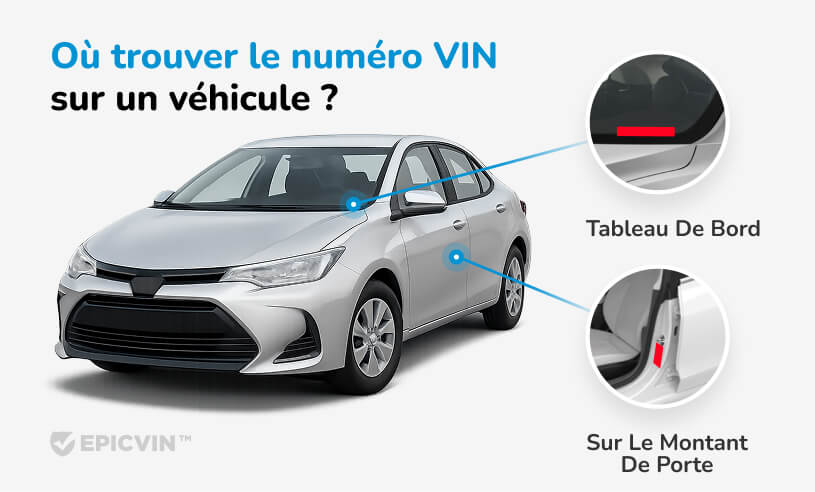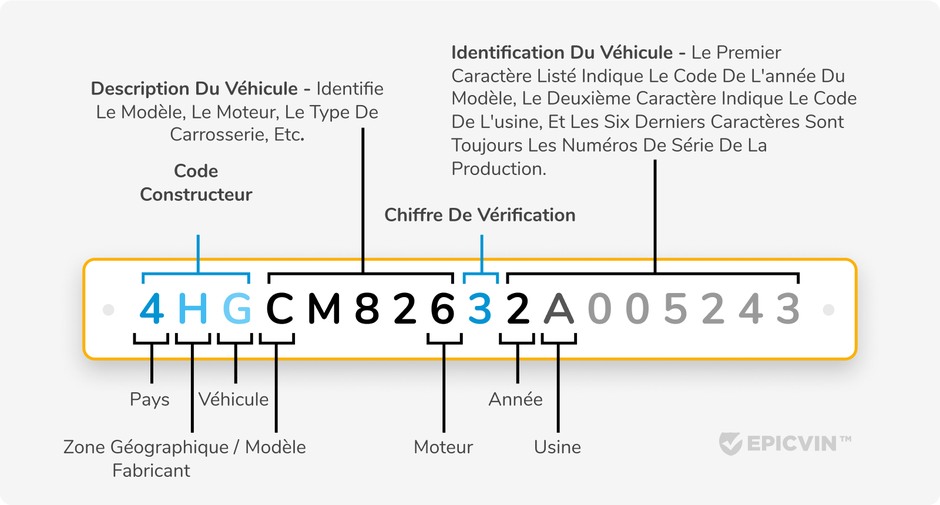
Décodage du numéro d'identification du véhicule (VIN)
Dans cet article, nous avons décrit en détail ce qu'est le code VIN.

Décodeur Mazda gratuit ! 🚗 Consultez les spécifications, la fiche technique, les rappels et l'historique de base - sans inscription. 🛡️✅ Besoin d'informations sur les accidents, le kilométrage, le titre ? Passez à la version premium en un clic.
À la recherche du VIN ?
Voici où vous le trouverez :

Trouvez un numéro d'identification de véhicule unique de 17 caractères dans chaque véhicule Mazda. Cette séquence, standardisée en 1981, agit comme l'empreinte digitale de votre voiture. Notre décodeur VIN interprète avec succès ces caractères. Identifiez la compatibilité des pièces Mazda authentiques, le statut de rappel et les spécifications essentielles avant de prendre une décision d'achat sans aucun inconvénient.
Our Mazda VIN decoder simplifies the process in four straightforward steps:

Voici les emplacements les plus courants où le VIN de votre Mazda est placé :
| Indicateur | Ce que Cela Signifie |
|---|---|
| ≈ 5 300 lots Mazda sur les principales plateformes d'enchères d'assureurs (juillet 2025, heure du Pacifique) | L'inventaire combiné Copart + IAA comprend 2 318 voitures avec titres de récupération et 3 012 lots endommagés affectant certains vehículos avec risque de dommages corporels graves. |
| Kilométrage annuel moyen ≈ 8 900 miles | La recherche indépendante (2025) a montré que la Mazda3 moyenne parcourt 137,7k miles sur 15,4 ans (≈ 8,9k miles/an), ce qui est en dessous de la moyenne du marché : les voitures « s'usent » plus lentement. |
| Chance de survivre 200k miles : ≈ 3% | De la même base de données de plus de 2 millions de voitures, seulement 3% des berlines Mazda atteignent 200 mille miles, proche de la moyenne pour les marques grand public. |
| Principales campagnes de rappel 2024-25 | • 9,9k voitures (CX-90, 24V-349) : activation de freinage erronée ; • 38,9k voitures (CX-90 / CX-70, 24V-816) : le moteur peut ne pas redémarrer après i-Stop ; • 12,2k voitures (MX-5 2024-25, 25V-336) : dysfonctionnement du système DSC |
Note : Avant l'achat, passez le VIN dans EpicVIN. Identifiez si la voiture tombe sous des campagnes ouvertes ou cache des réparations coûteuses qui pourraient affecter la sécurité.
| Problème | Statistiques et Détails du Problème |
|---|---|
| Freinage erroné (CX-90) | Le rappel de sécurité 24V-349 couvre ≈ 9 900 modèles CX-90 2024 : le capteur radar peut « voir » des obstacles inexistants et activer les freins à 10-15 mph pendant la conduite normale. |
| Le moteur ne redémarre pas après i-Stop | Le rappel 24V-816 affecte ≈ 38 900 modèles CX-90 et CX-70 2024-25 : la défaillance du logiciel PCM/ECM peut laisser le véhicule sans alimentation aux intersections. |
| Dysfonctionnement de l'indicateur DSC (MX-5) | Rappel 25V-336 : ≈ 12 200 modèles MX-5 Miata 2024-25 ; en raison d'une erreur logicielle, le voyant ESC ne s'allume pas pendant le dysfonctionnement, augmentant le risque d'accident et de perte de contrôle. |

Chaque caractère dans la séquence unique de votre véhicule raconte une histoire spécifique. Voici le format VIN standard :
Voici un échantillon de séquence (JM1NC2MF0D0229257) que notre décodeur VIN Mazda peut interpréter :
| Symboles | Échantillon | Ce qu'il Révèle |
|---|---|---|
| 1 | J | Japon comme pays d'origine |
| 2 | M | Mazda comme fabricant |
| 3 | 1 | Type de véhicule de tourisme |
| 4-8 | NC2MF | Modèle spécifique (MX-5), style de carrosserie, type de moteur et système de retenue |
| 9 | 0 | Chiffre de contrôle pour validation |
| 10 | D | Année modèle 2013 |
| 11 | 0 | Usine d'assemblage d'Hiroshima |
| 12-17 | 229257 | Numéro de série individuel du véhicule |
Année 2023
Marque Mazda
Modèle CX-5
Type de carburant Gasoline
Moteur 2.5L In-Line PY
Fabriqué en JAPAN
Notre décodeur VIN Mazda révèle des informations essentielles du véhicule dans plusieurs catégories :
Avant de payer pour un véhicule Mazda d'occasion, passez son VIN dans EpicVIN. En quelques secondes, vous verrez l'équipement d'usine - de Carbon Edition à l'hybride rechargeable - et apprendrez sur les rappels ouverts, retours d'odomètre et titres de récupération. Les faits vérifiés économisent des milliers et protègent les clients des surprises coûteuses.Alex Black, CMO et expert automobile, EpicVIN
Oui. D'abord, saisissez le VIN. EpicVIN affiche instantanément les données de construction de base. Cela inclut la famille de modèles (CX-5, Mazda3, MX-5, etc.), le type de moteur, le style de carrosserie, la finition et l'usine.
Un rapport EpicVIN payant ajoute différents types d'informations précieuses. Cela inclut les données de titre NMVTIS, retours d'odomètre, marques de récupération ou d'inondation, informations de rappel ouvertes, événements de perte totale d'assurance, photos d'enchères antérieures et entrées de service vérifiées de concessionnaires autorisés.
Absolument. Chaque décodage EpicVIN se connecte à la base de données de rappels NHTSA en temps réel. Tout rappel de sécurité actif apparaît avec sa description et instructions de réparation, pour que les propriétaires puissent contacter leur concessionnaire Mazda pour le service.
Oui. Notre décodeur VIN Mazda lit tout VIN construit depuis 1981. Cela inclut les classiques comme la MX-5 génération NC ou la RX-8 à moteur rotatif. L'outil est utile lors de la recherche de véhicules spécialisés.
Saisissez le VIN et vous verrez des données détaillées pour les options de groupe motopropulseur, systèmes i-ACTIV AWD et packages d'apparence. Pour de nombreux modèles récents, nous affichons également le PDSF original (prix de détail suggéré par le fabricant) et les options d'usine, vous aidant à décider sur la compatibilité des pièces Mazda authentiques. Les vidéos et données supplémentaires aident les clients à comprendre les caractéristiques spécifiques de leur modèle dans différentes conditions de température présentes pendant la fabrication.
Les numéros VIN de Mazda expliqués:
1er-3ème caractères : Fabricant et région (par exemple, « JM1 » indique Mazda, Japon).
4e-8e caractères : Détails du véhicule, comme le type de carrosserie et le code du moteur.
9e caractère : Chiffre de contrôle pour l'authenticité.
10e caractère : Année du modèle (par exemple, « L » pour 2020).
11e caractère : Usine de fabrication.
12e-17e caractères : Numéro de série ou séquence de production.
Oui, il est généralement sans danger de communiquer le numéro d'identification de votre véhicule Mazda à des fins légitimes, par exemple pour obtenir une fiche de construction, vérifier les spécifications ou commander des pièces. Évitez d'afficher publiquement votre numéro de châssis afin de réduire les risques d'usurpation d'identité liés à la falsification de l'identification du véhicule.
Utilisez les trois premiers caractères du NIV pour l'identification. Par exemple, « JM1 » indique que la Mazda a été fabriquée au Japon. Ce détail permet de confirmer les spécifications par VIN et de s'assurer que vous recevez des informations spécifiques à votre région concernant votre Mazda. Voici quelques exemples:
Oui, utilisez un décodeur de VIN pour accéder aux caractéristiques de votre Mazda par VIN. Cela comprend les caractéristiques optionnelles telles que le toit ouvrant, le système d'infodivertissement ou les packs de sécurité avancés. La fiche de construction de votre concessionnaire Mazda peut fournir une liste complète des caractéristiques installées en usine pour une identification précise.
Le numéro d'identification du véhicule (NIV) de Mazda indique clairement le modèle CX que vous possédez, ce qui permet de distinguer les modèles similaires tels que les CX-30, CX-5 et CX-50. Le huitième chiffre de votre VIN indique spécifiquement la série, ce qui facilite l'identification de votre modèle de crossover exact et évite les confusions.
Découvrez des conseils d'experts, des astuces et des informations sur l'achat et l'entretien de véhicules d'occasion.

Dans cet article, nous avons décrit en détail ce qu'est le code VIN.

Dans notre article, vous apprendrez à lire correctement nos rapports d'histori...

Dans ce billet, nous allons passer en revue les types de titres de marque les...